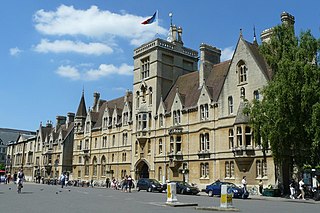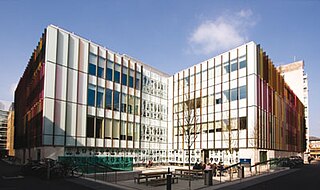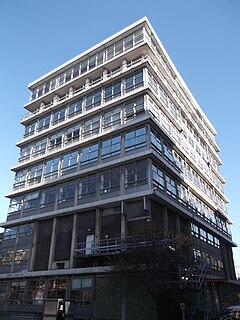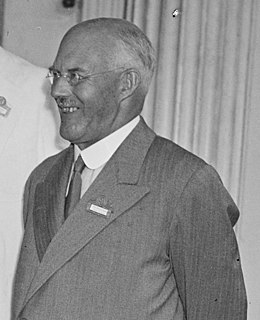
Balliol College is one of the constituent colleges of the University of Oxford in England. One of Oxford's oldest colleges, it was founded around 1263 by John I de Balliol, a landowner from Barnard Castle in County Durham, who provided the foundation and endowment for the college. When de Balliol died in 1268, his widow, Dervorguilla, a woman whose wealth far exceeded that of her husband, continued his work in setting up the college, providing a further endowment and writing the statutes. She is considered a co-founder of the college.

Trinity College is one of the constituent colleges of the University of Oxford in England. The college was founded in 1555 by Sir Thomas Pope, on land previously occupied by Durham College, home to Benedictine monks from Durham Cathedral.

The Cavendish Laboratory is the Department of Physics at the University of Cambridge, and is part of the School of Physical Sciences. The laboratory was opened in 1874 on the New Museums Site as a laboratory for experimental physics and is named after the British chemist and physicist Henry Cavendish. The laboratory has had a huge influence on research in the disciplines of physics and biology.

Sir John Edward Lennard-Jones was a British mathematician and professor of theoretical physics at the University of Bristol, and then of theoretical science at the University of Cambridge. He was an important pioneer in the development of modern computational chemistry and theoretical chemistry.

Edmund ("Ted") John Bowen FRS was a British physical chemist.

Humphry John Moule Bowen was a British botanist and chemist.

The Department of Computer Science is the computer science department of the University of Oxford, England, which is part of the university's Mathematical, Physical and Life Sciences Division. It was founded in 1957 as the Computing Laboratory. By 2014 the staff count was 52 members of academic staff and over 80 research staff. The 2019, 2020 and 2021 Times World University Subject Rankings places Oxford University 1st in the world for Computer Science. Oxford University is also the top university for computer science in the UK and Europe according to Business Insider. The 2020 QS University Subject Rankings places The University of Oxford 5th in the world for Computer Science.
Peter Day was a British inorganic chemist and Professor of Chemistry at University College London (UCL).

The Oxford University Science Area in Oxford, England, is where most of the science departments at the University of Oxford are located.

The Department of Biochemistry of Oxford University is located in the Science Area in Oxford, England. It is one of the largest biochemistry departments in Europe. The Biochemistry Department is part of the University of Oxford's Medical Sciences Division, the largest of the university's four academic divisions, which has been ranked first in the world for biomedicine.

The Department of Engineering Science is the academic department dedicated to teaching and researching engineering at the University of Oxford, which is part of the university's Mathematical, Physical and Life Sciences Division. It is principally located on the triangular plot formed by Banbury Road to the west, Parks Road to the east and Keble Road to the south. The main building is the tall 1960s Thom Building that dominates the local landscape, especially the view from the University Parks to the east. Further lower buildings have been added to the north since then. The department shares buildings with the Department of Materials.

Brigadier-General Sir Harold Brewer Hartley was a British physical chemist. He moved from academia to important positions in business and industry, including serving as Chairman of the British Overseas Airways Corporation.
David Edwin Logan is a Northern Irish chemist, and has been Coulson Professor of Theoretical Chemistry at the University of Oxford since 2005.

Iain Donald Campbell was a Scottish biophysicist and academic. He was Professor of Structural Biology at the University of Oxford from 1992 to 2009.

The Department of Chemistry at the University of Manchester is one of the largest Departments of Chemistry in the United Kingdom, with over 600 undergraduate and more than 200 postgraduate research students.

The Department of Chemistry is the chemistry department of the University of Oxford, England, which is part of the university's Mathematical, Physical and Life Sciences Division

The Abbot's Kitchen in Oxford, England, is an early chemistry laboratory based on the Abbot's Kitchen at Glastonbury Abbey, a mediaeval 14th-century octagonal building that served as the kitchen at the abbey.

The Balliol-Trinity Laboratories in Oxford, England, was an early chemistry laboratory at the University of Oxford. The laboratory was located between Balliol College and Trinity College, hence the name. It was especially known for physical chemistry.
Andrew Leslie Goodwin is a chemist. He is a university research professor and professor of materials chemistry at University of Oxford.

The Department of Biology, established in 2022, is a science department in the University of Oxford's Mathematical, Physical and Life Sciences Division. It was formed on 1 August 2022 after a merger between the Department of Plant Sciences and Department of Zoology.

















